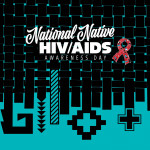After a hiatus due to the COVID-19 pandemic, blocks of the AIDS Memorial Quilt are once again available to be displayed at in-person events, according to the Quilt’s custodian, the National AIDS Memorial.
This means that the Quilt could be displayed at your community event or public space in time for World AIDS Day, December 1. The timing is also perfect because this year marks the 40th anniversary of the first reported cases of what’s now known as AIDS. And as the world continues to grapple with the COVID-19 pandemic, the lessons learned from AIDS continue to resonate.
“The issues our nation has faced in the past year—a raging pandemic with hundreds of thousands of lives lost, social injustice, health inequity, stigma, bigotry and fear—are also the issues faced throughout four decades of the AIDS pandemic,” notes the National AIDS Memorial. “The Quilt is a powerful teaching tool that shares the story of HIV/AIDS—the 700,000 lives lost in this country alone—and the hope, healing, activism and remembrance that it inspires. With HIV impacting younger populations and communities of color, particularly in Southern states, the Quilt can be used to raise greater awareness about prevention and treatments available.”
It is interesting to note that nearly the same number of Americans—700,000—have died of COVID-19.
To learn more about the requirements, registration and cost of displaying the Quilt, visit AIDSMemorial.org or email display coordinator Brian Holman at bholman@aidsmemorial.org. According to the site, costs begin at $600 per block.

A screengrab of the Interactive AIDS QuiltAIDSMemorial.org
Another option is to display the Quilt virtually in customized formats, on websites or via other virtual World AIDS Day programming.
Each of the Quilt’s 3-by-6-foot fabric panels memorializes someone lost to AIDS. The panels include stencils, photos, collages, paint, sewing and much more. Eight panels are sewn together to form a 12-foot-square block. (To learn how to create and submit a panel, visit “Make a Panel” on AIDSMemorial.org.)
Conceived in 1985 by Cleve Jones, an LGBTQ activist who created the first panel in June 1987, the Quilt was displayed at the National Mall in Washington, DC, for the first time later that year; it included 1,920 panels and was the size of a football field. It returned to DC a year later with more than 8,200 panels. The Quilt returned to the nation’s capital several times, including in 2012 as part of the International AIDS Conference that year. At 48,000 panels spanning the globe, the Quilt continues to grow and be displayed.
Anyone can peruse all the Quilt panels—for free—by visiting the interactive digital display of the Quilt on AIDSMemorial.org, which also lets you search the Quilt by name or block number.
The National AIDS Memorial, based in San Francisco, became the Quilt’s caretaker in 2019. For more details, see “AIDS Memorial Quilt—All 50,000 Panels—Is Moving to a New Home.” And in related news don’t miss “See Leftover Fabric From the AIDS Memorial Quilt Made Into Coronavirus Masks” and “Watch These Compelling, Hopeful Stories of Substance Abuse and HIV,” an article about a video collection recently posted by the National AIDS Memorial’s Surviving Voices initiative.







Comments
Comments